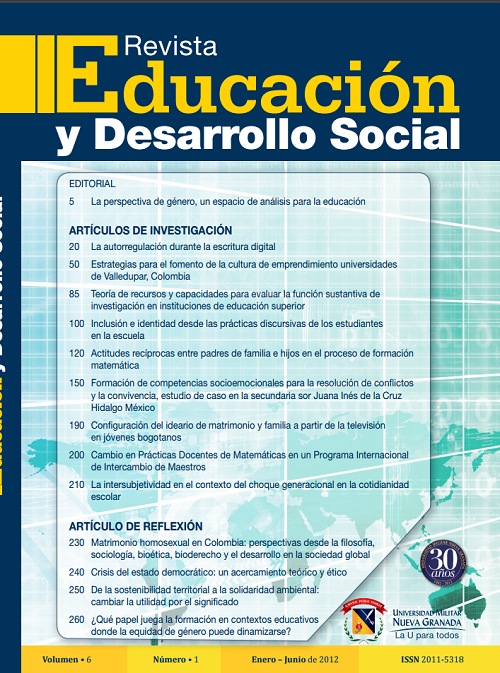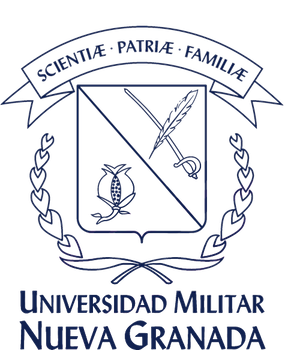The gender perspective, a space of analysis for education
Abstract
The journal ‘Education and Social Development’ is focused on publishing articles resulting from research, review and reflection issues in fields of knowledge that respond to contemporary sociological perspectives. In this context, they are presented conceptual aspects about gender, important to be taken into consideration by education and social development. The role of gender in the field of education is crucial. Its analysis and understanding provide to the different actors developments and epistemic advances that allow the comprehension and construction of spaces of equality, inclusion, fairness, innovation and respect in schools (Rebollo-Catalán, Piedra & Vega, 2009). The concept of gender can be understood from the “different sociocultural contents that are given to those characteristics between men and women” … “behaviors, attitudes and male and female feelings, and hierarchizing them, so a greater value is given to those who identify with the same” (Moreno Sanchez & Pichardo Galán, 2006). From a historical perspective, it is recognized that in the sixties of last century, it emerged the necessity of women of theorizing about gender inequalities, only after that the sociocultural conditions provided a space and significant condition in academia, and after some women had access to higher education and equality conditions, which, at the same time, made the pre-conditions necessary to open a path to a new academic consciousness called feminism (Lerner, 1986; Castro & Bronfman, 1993). Contrary to this, some authors assume that it had not given birth before because of the “self-imposed limitations of Marxist epistemology, functionalist / relativistic and empiricists,” preventing the “discovery of these matters” (Harding, 1983; Castro & Bronfman, 1993). That’s how the feminist theory is born, based on the origin of oppression and repression in women (Bart & Bundinger, 1984; Castro & Bronfman, 1993) being this the beginning of gender studies in the context of a decade marked by upheaval and social and ideological revolution in the West.Downloads
References
Alejo García, Ó. (1999). Laquear, Thomas. La construcción del sexo. Cuerpo y género desde los griegos hasta Freud, Madrid, ediciones cátedra, 1994. Signos Históricos. Revista Universidad Autónoma Metropolitana-Iztapalapa, I (1 Junio), 221-224
Bart, P. B., & Budinger, J. (1984). Feminist theories: Draft. (Mimeo).
Buttler, J. (1998). Actos performativos y constitución del género: un ensayo sobre fenomenología y teoría feminista. En Debate feminista. Año 9. Vol 18.
Connell, R. W. (2003). Masculinidades. México: Universidad Nacional Autónoma de México. Programa Universitario de Estudios de Género.
Hammarstrom, A. (1999). Why feminism in public health? Scand Journal Public Health, 27, 241-244.
Harding, S. (1983). Why has the sex/Gender system become visible only now? In S. Harding & M. B. Hintilkka (Eds.), Discovering Reality feminist perspectives on epistemology, metaphysics, methodology and philosophy of science. Boston: Reidel Publishing Coop.
Castro, R. P., & Bronfman, M. P. (1993). Teoría Feminista y Sociología Médica: Bases para una discusión. Cadernos Saude Pública, 9(3), 375-394.
Lamas, M. (1986). La antropología feminista y la categoría de género: Nueva Antropología.
Mendieta-Izquierdo, G. (2015). Prostitución viril: un estudio fenomenológico del cuerpo. Fundación Universitaria del Área Andina. [Acceso 12 de julio de 2015]. Disponible en: https://www.researchgate.net/publication/280534692_Prostitucin_viril_un_estudio_fenomenolgico_del_cuerpo DOI: 10.13140/RG.2.1.2903.2803
Mendieta-Izquierdo, G. (2015). Significado de la experiencia vivida de cuerpo en hombres que ejercen la prostitución en la Plaza Tapatía de Guadalajara, Jalisco, México. [Tesis doctoral en Internet]. México: Universidad de Guadalajara; 2013 [acceso 12 de Julio de 2015]. Disponible en: http://www.researchgate.net/publication/278329950_Prostitucin_viril._Significado_de_la_experiencia_vivida_de_cuerpo_en_hombres_que_ejercen_la_prostitucin_en_la_plaza_tapata_de_Guadalajara_Jalisco_México DOI: 10.13140/RG.2.1.3127.3128
Moreno Sánchez, A., Pichardo Galán, J. A. (2006). Homonormatividad y existencia sexual. Amistades peligrosas entre género y sexualidad. Revista de Antropología Iberoamericana, 1(001), 143-156.
Muñiz, E. (2003). Cuerpo, representación y poder. México en los albores de la reconstrucción nacional, 1920-1934. México, D.F: Universidad Autónoma Metropolitana. Unidad Azcapotzalco.
Núñez Noriega, G. (1999). Sexo entre varones. Poder y resistencia en el campo sexual (Segunda ed.). México, D.F: Coordinación de Humanidades, UNAM. Programa Universitario de Estudios de Género, UNAM. Instituto de Investigaciones Sociales, UNAM, El Colegio de Sonora.
Lerner, G. (1986). The creation of Patriarchy. New York: Oxford University Press.
Rebollo-Catalán, M.A., Piedra, J., & Vega, L. (2011). Diagnóstico de la cultura de género en educación: actitudes del profesorado hacia la igualdad. Revista de Educación. 355: 521-546. DOI: 10-4438/1988-592X-RE-2010-355-035













